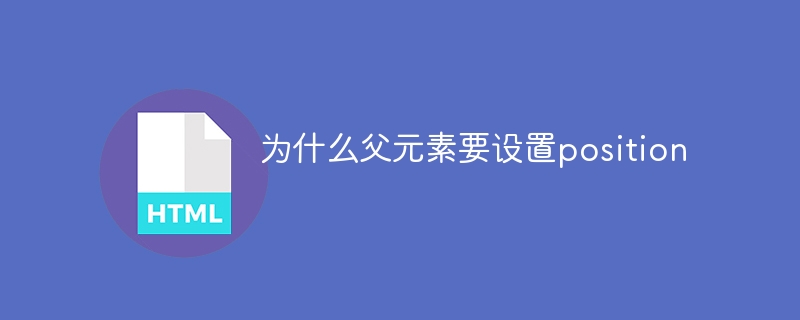
The parent element sets position to control the positioning and layout of its child elements. Different values have different uses: 1. static, which allows elements to be laid out according to the normal document flow and is not affected by other positioning attributes; 2. relative, which creates a relatively positioned container to wrap child elements and control them. Layout; 3. Absolute, creates an absolutely positioned container, used to control the precise positioning of child elements; 4. Fixed, creates a fixed positioned container, used to create a fixed element on the page, etc.

# Operating system for this tutorial: Windows 10 system, Dell G3 computer.
The purpose of setting the position attribute of a parent element is to control the positioning and layout of its child elements. The position attribute can be used to change the positioning method of elements. Common values include static, relative, absolute and fixed.
1. static:
static is the default value of the position attribute. The elements are laid out according to the normal document flow and are not affected by other positioning attributes. If the parent element does not set the position attribute, the positioning of the child elements will also be laid out according to the normal document flow, that is, the child elements will be arranged according to their order in HTML.
2. relative:
When the parent element sets the position attribute to relative, the positioning of the child element can be relative by setting the top, right, bottom and left attributes. The parent element is offset. This positioning method does not change the position of the child element in the document flow, but is offset relative to the parent element.
A common application scenario for setting position:relative on a parent element is to create a relatively positioned container to wrap child elements and control their layout. By setting the top, right, bottom and left attributes of the child element, the positioning and layout of the child element relative to the parent element can be achieved.
3. absolute:
When the parent element sets the position attribute to absolute, the positioning of the child element can be offset relative to its nearest positioned ancestor element. If there are no positioned ancestor elements, the positioning of child elements is offset relative to the original containing block of the document.
A common application scenario for parent elements to set position:absolute is to create an absolutely positioned container to control the precise positioning of child elements. By setting the top, right, bottom, and left attributes of the child element, you can achieve precise positioning of the child element relative to the parent element or the initial containing block of the document.
4. fixed:
When the parent element sets the position attribute to fixed, the positioning of the child element will be offset relative to the browser window. This positioning method will not change with scrolling, and the child elements will always remain in a fixed position.
A common application scenario for setting position:fixed on a parent element is to create a fixed-positioned container to create a fixed element on the page, such as a navigation bar or floating box.
Summary:
The purpose of setting the position attribute of a parent element is to control the positioning and layout of its child elements. You can change how a child element is positioned relative to its parent element or document by setting the position attribute to relative, absolute, or fixed. This positioning method can achieve relative positioning, absolute positioning or fixed positioning of sub-elements, thereby achieving a more flexible layout effect.
The above is the detailed content of Why does the parent element need to set position?. For more information, please follow other related articles on the PHP Chinese website!
 There are several ways to position CSS position
There are several ways to position CSS position
 How to solve the problem of missing steam_api.dll
How to solve the problem of missing steam_api.dll
 How to implement h5 to slide up and load the next page on the web side
How to implement h5 to slide up and load the next page on the web side
 What is the principle and mechanism of dubbo
What is the principle and mechanism of dubbo
 How to resume use of gas after payment
How to resume use of gas after payment
 How to modify the text in the picture
How to modify the text in the picture
 What are the methods for restarting applications in Android?
What are the methods for restarting applications in Android?
 Where to buy Bitcoin
Where to buy Bitcoin
 How to open WeChat html file
How to open WeChat html file




